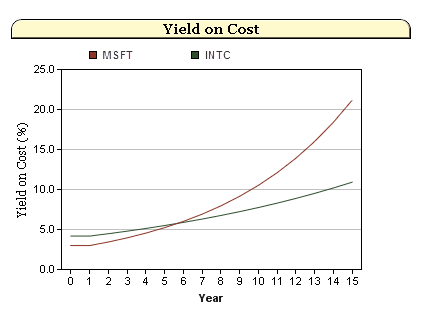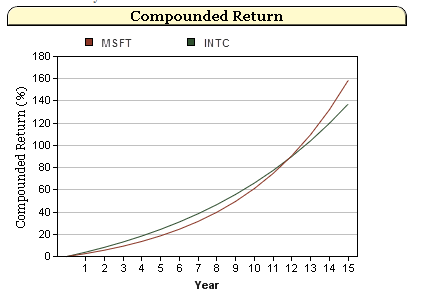When it comes to technology companies, few did better for investors in the 90s than Microsoft (MSFT) and Intel (INTC). It was truly an amazing run for these two tech giants as Microsoft returned an incredible 9,000% during this decade while Intel returned 3,300%.
Those days are long gone for these two now-mature companies. Their stock prices have languished for over ten years now. But this doesn’t mean we shouldn’t look at them as a solid investment opportunity. To the contrary, both of these companies now fit nicely into a dividend growth portfolio.
Let’s take a look at what investors might expect if Microsoft and Intel continue paying out increases in their dividends.
| MSFT: | | Div Yield | 1 Yr Div
Growth Rate | 5 Yr Div
Annual Growth Rate | | 2.6% | 25% | 20% | | | | INTC: | | Div Yield | 1 Yr Div
Growth Rate | 5 Yr Div
Annual Growth Rate | | 3.9% | 7.1% | 20% | |
The first striking thing we notice is the phenomenal growth rate of Microsoft’s dividend, both over the past year and the past five years. There are not many companies with a 20% average dividend growth rate over the past five years.
Although Intel’s one year dividend growth rate does not match Microsoft’s, its five year growth rate does and its dividend yield is higher.
This presents a great case study in which company will give the investor a higher return due to dividends over time. More specifically, I want to measure the Yield on Cost (YOC) and how it changes over time as well as the compounded annual return due to dividends. The YOC simply measures the annual dividend divided by the original investment in the company’s stock.
It would probably not be realistic to assume that Microsoft will continue its 25% dividend growth rate that we saw over the past year. So I assumed that Microsoft’s dividend will grow at an average rate of 15% over the next 15 years while Intel’s will grow at 7%. I ran the following results in our free calculator called Dividend Yield And Growth.

It takes six years for the YOC for Microsoft to break even with the YOC for Intel. Of course, due to compounding we see the YOC for Microsoft explode upward eventually. But this assumes that the company can continue the relatively high rate of dividend growth rate of 15% going forward.
Although the yield on cost breaks even after three years, it takes slightly longer for the compounded total returns to break even; it takes twelve years for the returns to break even. It is also important to note that I do not consider any price appreciation in these calculations and compounded returns are due solely to dividends.

This is an interesting case study in dividend investing because we can see that by investing in Microsoft for its dividends, one would be betting on the company maintaining a high level of dividend growth. If they do, this would be a wonderful long-term investment where the stock price becomes nearly meaningless since the vast majority of return would be due to dividends.
Intel is also a nice long-term investment because of its already relatively high dividend yield combined with a history of strong dividend growth.
It is also important to point out that dividend paying stocks such as Microsoft and Intel can help a retirement plan immensely, especially vs. low-yielding treasury bonds. I plugged in the two stocks I analyzed here I into our retirement plannerin place of the ten treasury bonds that were in the portfolio before.
I found that if a typical 55 year old couple with $400,000 in assets moves 50% of their funds from treasuries to dividend payers such as Microsoft and Intel, over ten years they will have increased the time that their funds last in retirement by over 13 years.
When constructing a dividend portfolio for the long-run, it is important to keep in mind just how important both the dividend growth and the yield are over time. Selecting companies which have consistently strong dividend growth over long time periods can mean the difference between early retirement and working a lot longer.